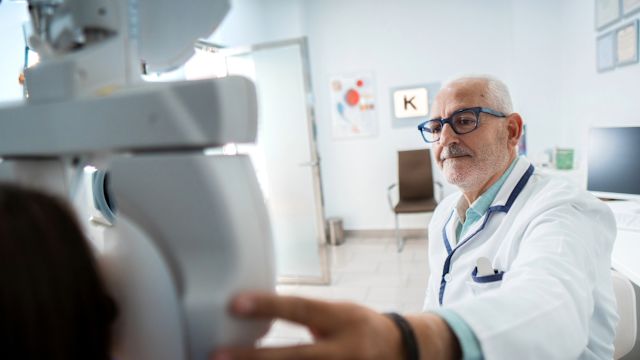Updated on November 19, 2024
Age-related macular degeneration (AMD) is a disorder that damages the macula. The macula is a cluster of light-sensitive cells located in the back of the eyeball. The light-sensitive cells that make up the macula are called photoreceptor cells. These cells convert light that enters the eyeball into nerve signals that travel to the brain.
In other words, the macula plays a very important role in a person’s vision. Specifically, it enables central vision, the ability to focus and clearly see details directly in front of the eyes. Tasks like reading, driving, and measuring ingredients all rely on central vision.
AMD damages the macula, causing a loss of photoreceptor cells and a loss of central vision. As the name implies, age is a significant risk factor for AMD, and AMD is the leading cause of vision loss in adults over the age of 60. However, AMD can and does occur at younger ages.
How is AMD treated?
There is no cure for AMD. In the early stages of the disease, the only treatment options are steps that may help slow the progression of the disease—changes to diet, quitting smoking (for anyone who smokes), managing blood pressure and cardiovascular health, and protecting the eyes from sunlight.
The advanced stages of the disease are called wet AMD and geographic atrophy:
- Wet AMD involves the growth of new, abnormal blood vessels in the eye, which leak fluid and cause more severe and more rapid vision loss.
- Geographic atrophy is characterized by patches of dead photoreceptor cells that grow in size over time.
There are medications available for both wet AMD and geographic atrophy, which are given as injections into the eye. These medications can help slow the progression of damage and vision loss.
What healthcare providers treat AMD?
A person may work with several different healthcare providers when treating AMD. Here is a quick guide to who those healthcare providers are and where they fit into a treatment plan for AMD:
Ophthalmologist
An ophthalmologist is a medical doctor that specializes in diseases and conditions that affect the eye. This is typically the provider that oversees treatment for AMD. For anyone being treated for an advanced form of AMD, an ophthalmologist will be the provider who administers injections of medications into the eye. In many cases, AMD is treated by a retina specialist, an ophthalmologist with specialized training in diseases that affect the retina (the part of the eye that contains the macula).
Optometrist
An optometrist is a healthcare provider who performs eye exams and prescribes eyeglasses. Because eye exams include tests to check for signs of AMD, in many cases an optometrist will be the first healthcare provider a person talks to about signs and symptoms, and will be the provider who writes a referral to an ophthalmologist.
Low vision specialist
Low vision rehabilitation is a supportive treatment for AMD and vision loss. A low vision specialist will assess a person’s vision and needs. They will recommend ways to make the most of vision that has been impaired, such as the use of assistive devices, changing the lighting in a home, and adapting to other areas of day-to-day functioning. A program may also include counseling and social support.
Primary care provider
A primary care provider is the healthcare provider a person sees for preventive care and common health concerns. Primary care providers also make referrals to specialists that treat more specific health concerns, and coordinate care among the different healthcare providers a person is working with. People with AMD should work with a primary care provider to manage overall health and other health concerns. This may include health concerns that are related to AMD, such as managing cholesterol and blood pressure.






